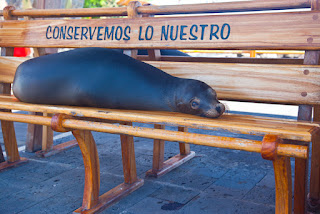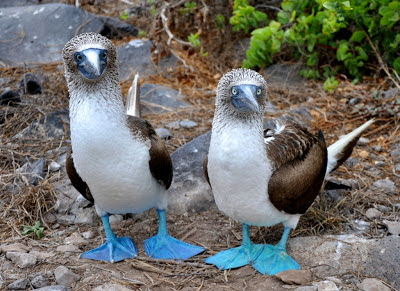Ask any visitor to the Galapagos Islands what they loved about their trip and they are bound to tell you all about our fabulous Blue Footed Boobies. I mention them in many of my posts because we see them on every Island. Typically when I write about those funny,
clown-like and fascinating inhabitants of the Galapagos Islands, I talk about their mating habits and their adorable and irresistible little
chicks. Any one lucky enough to experience their mating dance will have a memory to last a lifetime. I show this ritual in my Espanola Post.
I'm often asked why these birds have blue feet. It's a particularly intriguing question because almost every Galapagos animal or bird species blends into the stark volcanic environment with its pallet a range of brown, beige, sepia, and black, interspersed with green scruffy plant life. How then did they end up with bright blue feet - and electrifying color in contrast to the earthy tones? The answer goes right back to the mating ritual. The males strut around displaying their feet to the females who, in turn, are attracted to that azure color. The bluer the better and more magnetic. The Boobies' feet serve the same purpose as the coloration of so many male birds, like cardinals or frigatebirds.
Sunday, 16 December 2012
Friday, 7 December 2012
Rabida Island
 | |||
| Approaching Rabida from Boat by Mark Putney |
Rabida is located in the center of the Galapagos Islands. It’s a marvelous area for snorkeling as the water teems with fish, marine iguanas and our beloved sea lions. It also offers a special and unique landscape, including the opportunity to walk on a rocky red sand beach.
Labels:
Galapagos,
Rabida island,
Red Sand Beach,
Tourist Sites
Thursday, 6 December 2012
Galapagos Sea Lions - They Are Definitely Not Seals!
 |
| Sea Lion Basking on a Bench in Puerto Baquerizo Moreno |
 |
| Sea Lion Pup |
Labels:
About the Galapagos Islands,
Fur Sea Lion,
Fur Seal,
Sea Lion,
Seal,
Wild Life
Subscribe to:
Comments (Atom)
